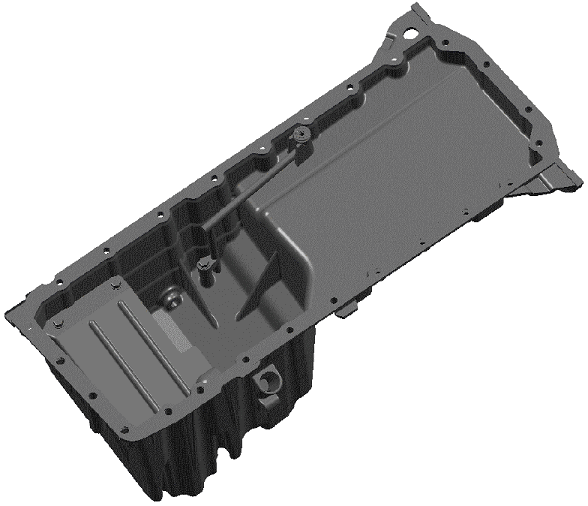Subjects:
- Carter pan
- oil strainer
- Disassembly/assembly of the oil sump
oil pan:
A sump pan is mounted under almost every petrol and diesel engine. This is called a “wet-sump system”. Engines without a sump pan use a dry sump system. The oil pan is, among other things, the storage place for oil. When the engine is standing still, 90% of the oil collects here. The rest is parts such as the cylinder head, oil pump, turbo, etc. Click here for more information about the engine oil. The oil screen (through which the oil is sucked in via the oil pump) is located at the lowest point of the crankcase.
There is almost always a drain plug at the bottom of the crankcase. This is located at the lowest point, and is intended for draining the oil during a service, for example. There are motors (eg old type Smart) that do not have a drain plug. The oil must then be extracted through a pipe with a special extraction device.
The oil pan on in the picture below is from a BMW. This one is quite flat. Some other specimens are a lot deeper. That is completely dependent on the engine construction with the crankshaft etc.
There is always a gasket between the engine block and the top of the oil pan. This can be paper, cork or rubber, but in most cases this is liquid sealant. This kit dries up when it comes into contact with the outside air.
A so-called "crankcase pressure" is built up in the crankcase pan. This is where the bottoms of the pistons/cylinders come out. The pressures are created by, among other things, the leakage gases along the piston rings. These crankcase vapors must be extracted by the engine. See the page Carter ventilation.

Oil strainer:
The oil pump sucks the oil from the crankcase and pumps it to the lubrication channels. At the beginning of the suction tube is a sieve (sometimes also called a crankcase filter). This sieve serves to retain coarse dirt particles before they end up in the oil pump. The sieve can become clogged by, for example; black sludge (when driving with old engine oil) or by sludge from the combustion of the engine oil. The latter can happen if the exhaust runs under or close to the sump. If the engine is under heavy load, so the exhaust is scalding hot and the engine is stopped too quickly, the heat from the exhaust will draw to the crankcase. The oil that is already very hot can burn at the level of the oil screen. This is, for example, a known problem of certain types of VW Passat, Audi A4 and Skoda Superb with a 1.8 turbo engine where the engine is located in the longitudinal direction.
The oil pressure light (red) may illuminate under certain conditions. It is then necessary to check the sieve for contamination, clean it if necessary and preferably replace it.
Disassembly/assembly of the oil pan:
In case of leakage of the sump pan gasket or if the sump is damaged, the sump will have to be disassembled. First, the engine oil must be drained. Depending on the type of engine, part of the exhaust (if it runs underneath) will also have to be disassembled. Sometimes the subframe has to lower. If there is enough space under the crankcase, all bolts can be loosened. The crankcase will be stuck to the engine block by the gasket that attaches both parts together. Carefully remove the crankcase.
When the crankcase is off, the old sealant remains are still stuck to everything. Otherwise, it could also be a loose rubber gasket, which is easiest to replace. With loose kit, all old kit remains must be removed from both the crankcase and the engine block. Do not use coarse sandpaper for this, because that makes (deep) scratches that can fill with motor oil. Both surfaces must of course remain as flat as possible.
After having made everything grease free, it is time to apply the new liquid gasket. Definitely do not put too much on it, because then parts of sealant can end up in the crankcase after mounting, which can clog the oil screen. Spread some sealant over the entire area of the crankcase mounting surface and remove excess sealant. After installation, motor oil can be added fairly quickly. It is advised to let it dry for at least an hour before driving the car.
